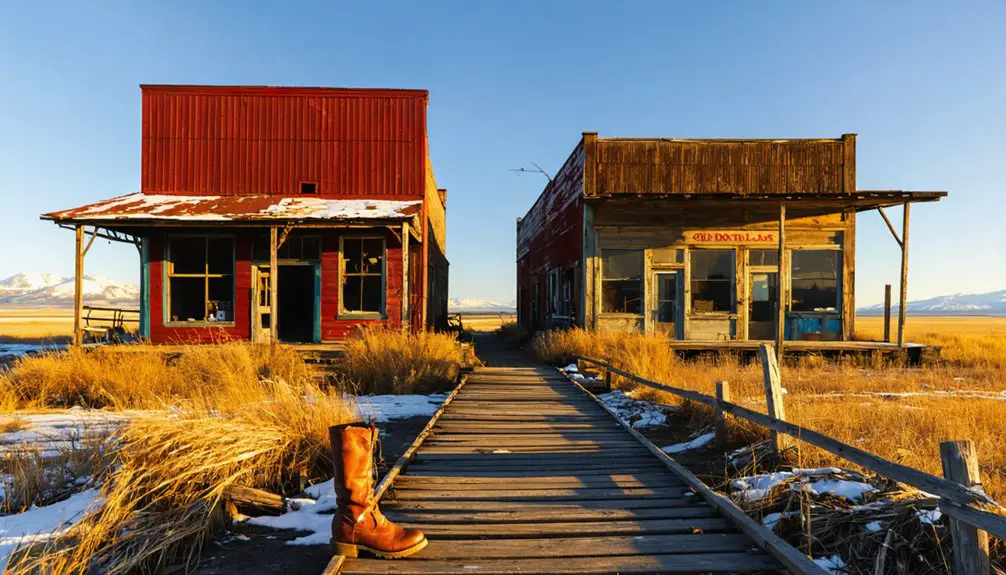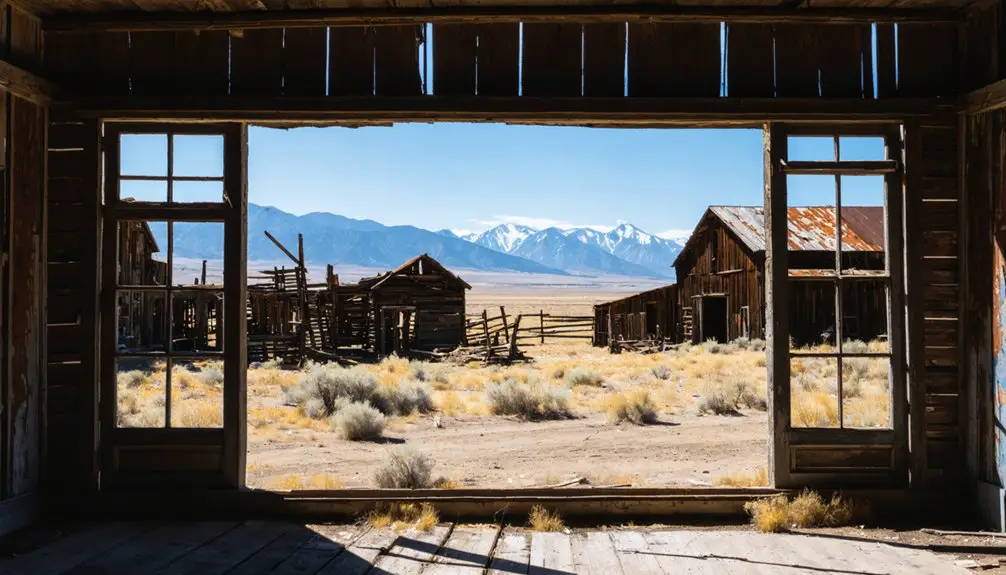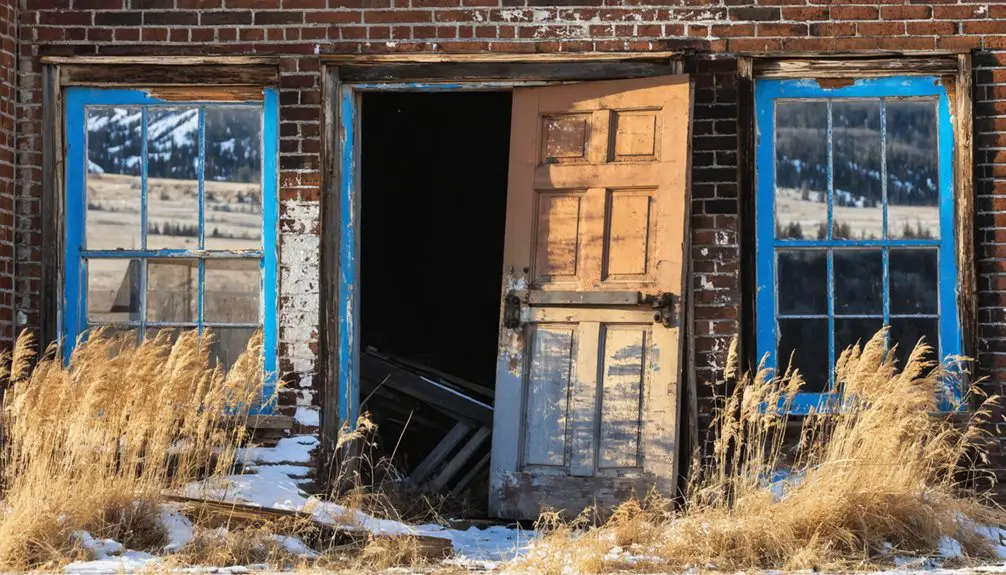You’ll find Sumatra, Montana along the historic Milwaukee Road railroad line, established in 1905 as “Summit” due to its elevation. The town, renamed in 1910, grew into a bustling community of 1,500 residents during Montana’s railroad boom. Today, you can explore its well-preserved remnants, including the original railroad grade and church building from 1910. The ghost town‘s quiet streets hold fascinating stories of railroad workers, homesteaders, and entrepreneurs who shaped this high-plains community.
Key Takeaways
- Sumatra originated as a Summit station stop in 1905 along the Milwaukee Road railroad, renamed in 1910 when its post office opened.
- Located at the highest point between Miles City and Harlowton, the town grew to 1,500 residents during Montana’s railroad boom.
- The town’s decline began with Milwaukee Road’s bankruptcy in the late 1970s, ending vital railroad service to rural communities.
- Key remnants include the original railroad grade, scattered bridge supports, and a wooden church built around 1910.
- The community thrived from 1910-1950, supported by railroad workers, homesteaders, and local businesses along the Milwaukee Road line.
The Birth of a Railroad Town
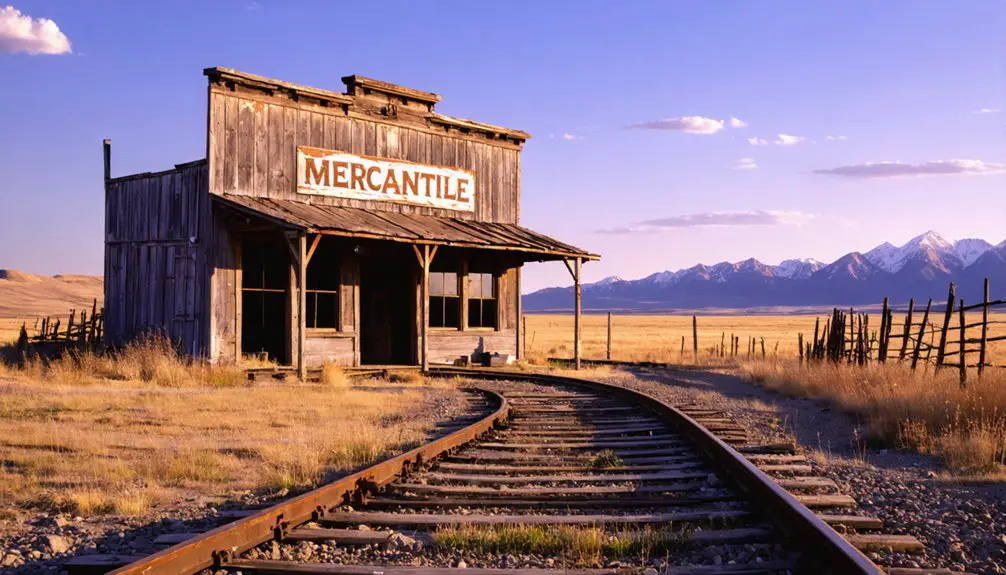
The birth of Sumatra, Montana began in 1905 as a humble station stop called Summit along the ambitious Milwaukee Road railroad line.
You’ll find this location was strategically chosen as the highest point between Miles City and Harlowton, requiring extra “pusher” engines to help trains climb the challenging grade.
The railroad expansion transformed what was once a simple trail between Fort Musselshell and Fort Custer into a bustling community.
By 1910, when the post office opened, the settlement patterns of the Milwaukee Road had established towns roughly every nine miles along the track.
The newly-named Sumatra quickly attracted rail workers, ranchers, and professionals who saw opportunity in this high-elevation outpost.
The Milwaukee Road’s rapid construction through Montana between 1907 and 1909 brought the essential supplies and workforce that would shape Sumatra’s early years. The ambitious project was completed in record time, with crews installing the final spike in 1909.
From Summit to Sumatra: A Name’s Journey
While many Montana railroad towns kept their practical, descriptive names, Summit underwent an intriguing transformation in 1910 when railroad officials renamed it Sumatra.
The name’s significance stemmed from an unexpected source – the Indonesian island of Sumatra, marking a distinctive departure from typical Western place names. You’ll find this cultural impact particularly fascinating, as it coincided with the establishment of the town’s first post office, signaling a shift from a mere railway stop to an official community.
This exotic name choice reflected the Milwaukee Road’s influence on local identity, though the reason for selecting an Asian island reference remains unclear.
The change from Summit to Sumatra represented more than just a new name – it symbolized the town’s brief moment of promise before joining Montana’s legion of ghost towns.
Life Along the Milwaukee Road
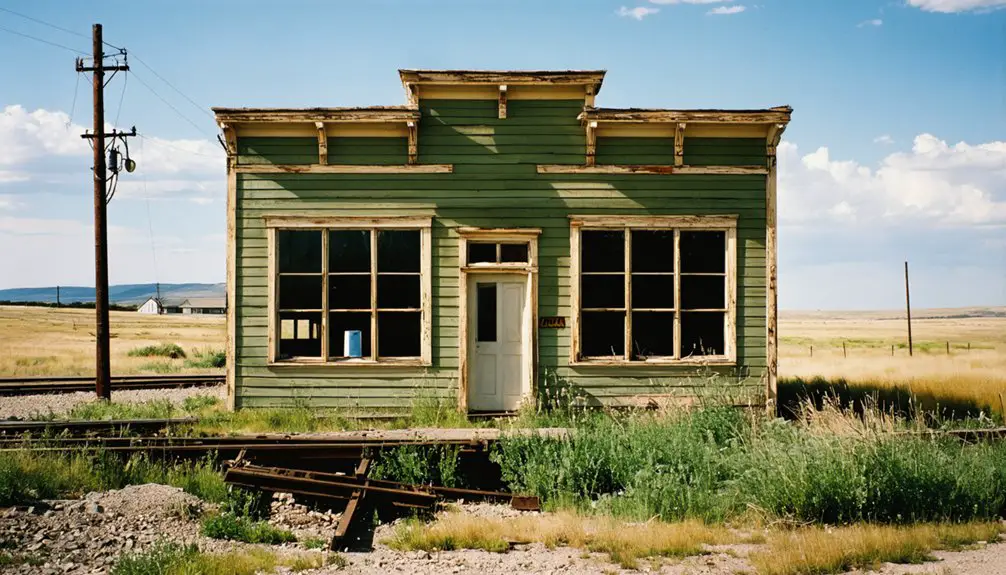
Life along Montana’s Milwaukee Road painted a vibrant picture of early 20th-century frontier development, with small cities springing up every nine miles along the rail line.
You’d find populations up to 1,500 people in these bustling communities, where doctors, bankers, lawyers, and pharmacists set up shop alongside railroad workers and ranchers.
The railroad’s impact peaked between 1910 and 1918, creating diverse local economies despite most settlers having only basic education.
This dramatic growth was part of a larger trend that saw Montana’s population double during the Milwaukee Road’s expansion.
But the prosperity wouldn’t last. Economic challenges, including severe droughts and post-war decline, forced about 75% of settlers to abandon their dreams by 1925.
Water scarcity particularly plagued towns like Sumatra and Ingomar, where communities relied on rail tank cars for their water supply.
Those who stayed faced isolation and limited resources in these once-promising frontier towns.
The Golden Years: 1910-1950
You’ll find Sumatra’s golden era began around 1910 when the Milwaukee Road railway transformed this empty stretch of Montana into a bustling community of 1,500 residents.
The town’s strategic location along the rail line attracted a diverse mix of settlers, from railroad workers to professionals like doctors and lawyers who established thriving businesses along the newly formed downtown streets.
Despite limited formal education and scarce water resources, the community flourished through the support of essential institutions like Sumatra’s high school, which helped maintain a stable population of about 375 residents well into the post-World War I period.
Railroad Prosperity Era
The arrival of the Milwaukee Road in Montana during 1907-1908 ushered in a remarkable period of prosperity for Sumatra and neighboring settlements. As the railroad carved its path across the region, you’d have witnessed Sumatra’s explosive growth, reaching 1,500 residents in less than a decade.
The railroad expansion brought unprecedented economic impact, with new businesses, ranchers, and professionals establishing themselves every nine miles along the line. The Milwaukee Road’s first expansion into the state came when they extended westward in 1905.
You would’ve seen the Milwaukee Road’s strategic development transform the region, especially after the 1914 electrification of the Rocky Mountain Division.
The Olympian passenger trains connected you to Chicago and the Pacific Coast, while freight services transported your agricultural products, timber, and wool. Local infrastructure and essential services expanded rapidly to support your thriving rail-dependent community.
Community Life Flourishes
While the railroad’s presence brought initial prosperity to Sumatra, community life truly flourished through the establishment of crucial social institutions between 1910 and 1950.
You’d find the church and post office serving as essential community gathering spots, where ranching families forged strong social cohesion despite their isolated locations. These hubs hosted seasonal events and religious services, creating bonds that helped residents weather the challenges of Montana’s semi-arid environment.
Ranch life dominated daily routines, with neighbors helping neighbors through informal cooperation. You’d see multi-generational households working together, sharing resources, and maintaining traditions. Similar to the Northern Cheyenne Exodus, families relied heavily on each other during harsh winters and difficult times.
Though the population gradually declined as younger folks moved to larger towns, the spirit of self-reliance remained strong. Local supply points and dirt roads kept residents connected, while agricultural activities sustained their independent way of life.
Population Peak Years
During Sumatra’s golden age between 1910 and 1950, three key factors drove the town’s population growth: railroad activity, ranching prosperity, and regional settlement patterns.
You’ll find that Sumatra’s population dynamics mirrored Montana’s broader expansion, as the state grew from 380,000 to 591,000 residents during this period.
The Milwaukee Road’s bustling presence brought steady traffic through Sumatra, while ranching families established deep roots in the community.
Like many rural Montana towns, you’d have witnessed modest but stable population numbers throughout the 1920s and 1930s, despite the rural challenges of limited infrastructure and economic opportunities.
The town’s composition remained largely homogeneous, consisting primarily of white ranching families who relied on the railroad and agricultural activities for their livelihood.
Notable Residents and Their Stories
As Sumatra’s population swelled to approximately 1,500 residents during its peak years, a diverse mix of railroad workers, homesteaders, and business owners shaped the town’s character. Notable figures included Milwaukee Road employees who established essential services and entrepreneurs who built the town’s prominent brick buildings, including the bank that later became the Jersey Lilly bar and restaurant.
Much like the town of Rocky Point, many residents documented their struggles through personal journals and letters. You’ll find that many resident stories revolve around the challenges they faced. Homesteaders struggled with poor soil conditions and limited water resources, while railroad workers dispersed to nearby towns like Ingomar after the Milwaukee Road’s closure in 1980.
During the 1920s oil boom, resourceful residents repurposed abandoned buildings, including the old schoolhouse, for oil equipment reclamation work. Like many communities along the abandoned Milwaukee Road, the town’s decline accelerated significantly after the railroad’s closure, leading to widespread building abandonment.
Architecture and Remaining Structures
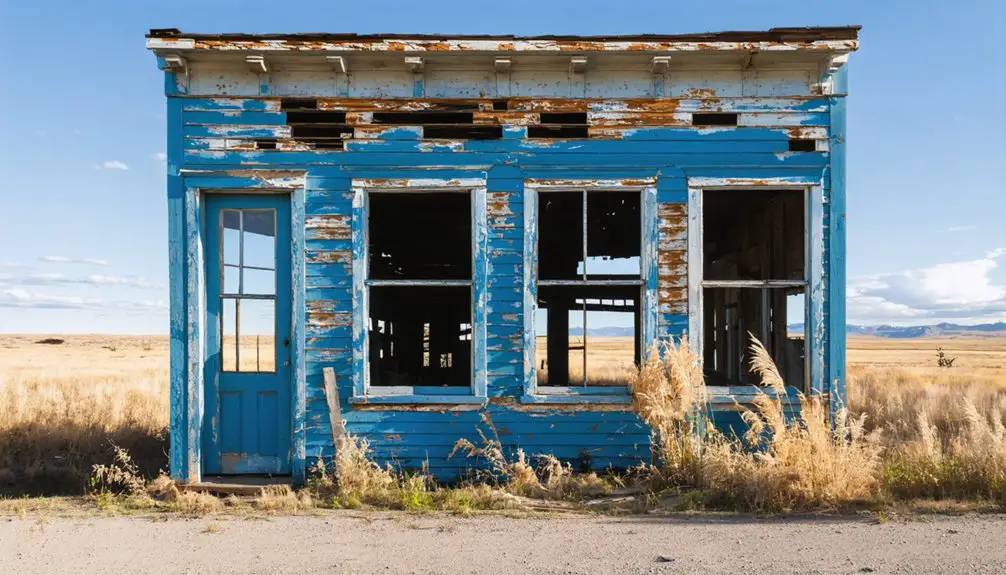
When you visit Sumatra’s townsite today, you’ll find the most prominent remnants are the railroad grade and scattered bridge supports that once carried the crucial rail line through town.
The former church building underwent several transformations before its collapse, reflecting the town’s changing needs as the population fluctuated. Like other mining communities, the town’s hospital provided care to residents who paid through small pay deductions. The miners earned wages of $3 to $3.50 per day working in the mines.
Residential structures, built hastily with local materials, followed typical boomtown patterns with houses aligned along the main thoroughfare and positioned for easy access to the railroad station.
Railroad Station Remnants
The original railroad station at Sumatra, Montana, established in 1905 as “Summit,” served as an essential transportation hub along the Milwaukee Road line until its dismantling in 1955.
Today, you’ll find only traces of this once-vital railroad architecture, including deteriorated rail ties and abandoned bridge supports that hint at its transportation legacy. The elevated rail grade still rises several feet above the current road surface, a silent reminder of the bustling freight and passenger stop that once stood here.
While the station’s wooden structure is long gone, the site’s layout followed typical rural Montana railroad design, featuring areas for freight handling and passenger services.
The railroad’s closure in 1960 marked the end of Sumatra’s rail era, leaving behind only these scattered remnants in the landscape.
Church Building Evolution
Standing as a symbol of Sumatra’s pioneering spirit, a modest wooden church building anchors this Montana ghost town’s remaining structural legacy. Built around 1910 when the town received its name, you’ll find this structure exemplifies early 20th-century rural Montana architecture with its practical design and weathered wooden exterior.
The church’s preservation stands out among Sumatra’s deteriorated landscape, where most other buildings have vanished. Its resilient frame and simple pitched roof have withstood decades of Montana weather, while its rectangular layout reflects the pragmatic building approaches of railroad stop communities.
Beyond its religious purpose, the building’s community significance extended to social gatherings and town meetings, serving as a crucial hub for homesteaders and ranch workers until Sumatra’s decline.
Residential Building Patterns
Despite Sumatra’s dwindling population, remnants of its residential architecture reveal a practical frontier settlement pattern centered along the railway grade.
You’ll find modest timber-frame homes with corrugated metal roofs arranged in tight residential clustering along rectangular lots, showcasing the town’s rail-dependent nature.
These working-class dwellings featured functional innovation in their design, including creative bathroom layouts and double powder rooms to maximize limited space.
Most homes were compact, consisting of one or two rooms plus kitchen areas, built on simple stone foundations.
Today, you’ll see mostly deteriorated structures with collapsed roofs and missing elements, though a few buildings near the post office remain partially intact.
Unlike other Montana ghost towns such as Virginia City, Sumatra’s homes lack organized preservation efforts, offering a raw glimpse into authentic frontier living.
The Decline of Rail Service
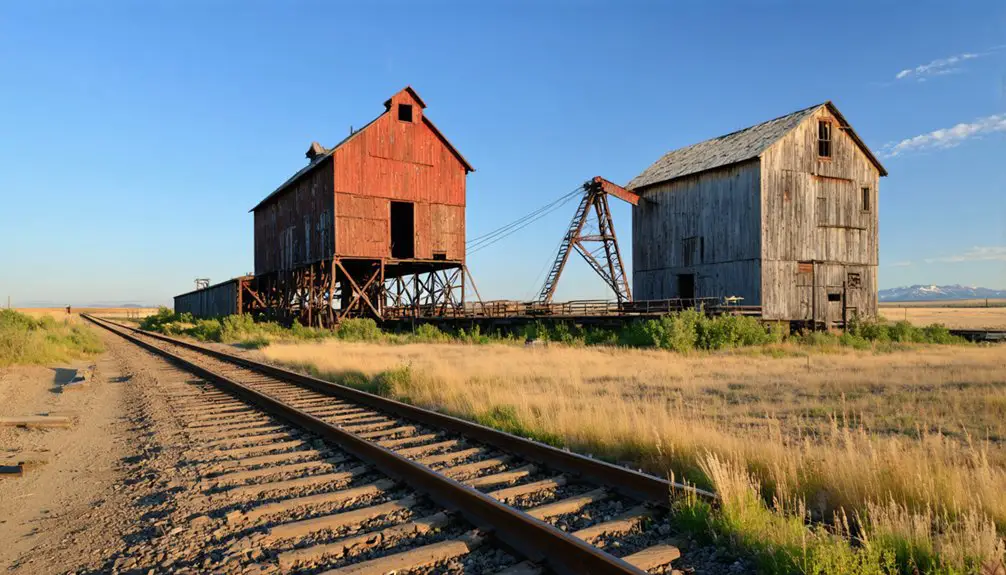
When Milwaukee Road filed for bankruptcy in the late 1970s, it marked the beginning of the end for many Montana railroad towns like Sumatra.
The rail service decline devastated local economies as towns lost their crucial transportation lifeline. You’ll find the economic impacts were particularly harsh in rural areas where trains had delivered essential supplies, including water via tank cars.
Key factors that sealed Sumatra’s fate:
- Competition from interstate trucking offered faster, more economical freight options
- Railroad companies abandoned unprofitable branch lines serving sparsely populated areas
- Congressional deregulation in 1980 made it easier for railroads to cease operations
Modern-Day Ghost Town Experience
Today’s visitors to Sumatra will find a haunting blend of historical ruins and natural beauty that characterizes Montana’s ghost towns.
You’ll discover atmospheric settings perfect for ghost town photography, especially during golden hour when twilight casts long shadows across weathered structures. Like many ghost towns, Sumatra offers guided interpretive tours of its historical sites. The site’s visitor accessibility allows you to explore at your own pace, though you won’t find the extensive interpretive signage present at larger ghost towns like Garnet.
Fall brings particularly striking photo opportunities as autumn foliage creates dramatic contrasts against the abandoned buildings. Like many mining boom towns, Sumatra’s population fluctuated dramatically with the success and failure of local mining operations.
While exploring, you can combine your historical investigation with outdoor activities, as the surrounding landscape offers opportunities for hiking and wildlife viewing.
The untamed environment around Sumatra provides an authentic glimpse into Montana’s frontier past without commercial tourist trappings.
Legacy in Montana’s Railroad History
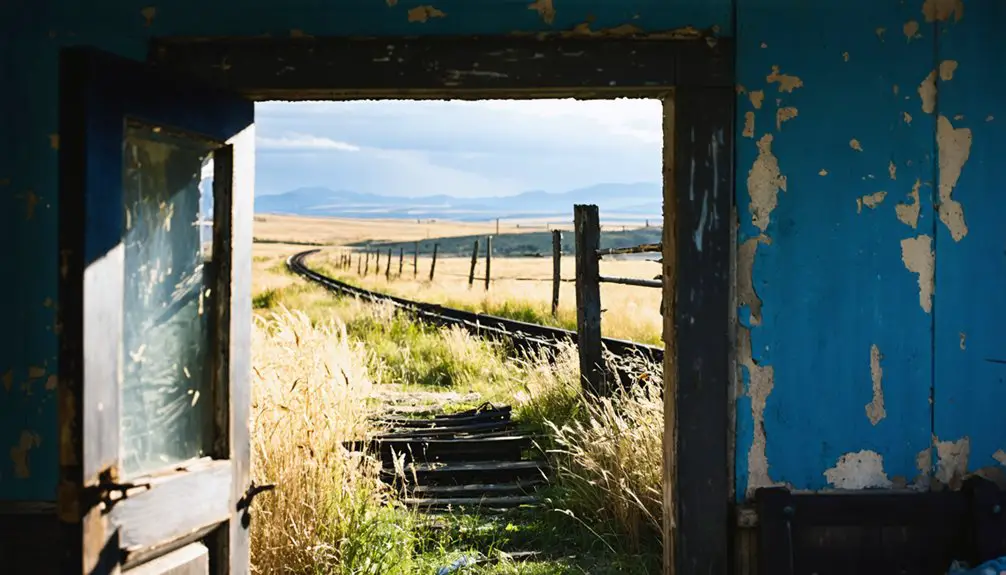
As a critical link in Montana’s railroad development, Sumatra emerged during the ambitious expansion of the Montana Railroad, which began in 1894 under Richard A. Harlow’s vision.
This railroad infrastructure played an essential role in connecting Montana’s central mining and agricultural regions, creating lasting economic impact across the territory.
You’ll find Sumatra’s railroad legacy reflected in these key developments:
- Part of the strategic expansion that connected Montana’s dispersed communities, linking mining districts to major transport hubs
- Integrated into the larger Milwaukee Road network after 1908, enhancing the region’s freight and passenger capabilities
- Served as a significant point in the railroad’s diversification beyond mining, supporting timber, coal, and agricultural transport
The town represents the broader story of how Montana’s railroads adapted to serve changing economic needs while connecting isolated communities across the challenging mountain terrain.
Frequently Asked Questions
What Was the Population of Sumatra at Its Peak?
Like a blooming desert flower that quickly withers, you’d find Sumatra’s history peaked at 1,500 residents during 1910-1918, before population decline struck this railroad stop, leaving only memories of bustling sheep-shearing days.
Are There Any Annual Events or Gatherings Held in Sumatra Today?
You won’t find any annual celebrations or community gatherings held in Sumatra today. Unlike Montana’s better-preserved ghost towns that host regular events, this remote site lacks the infrastructure and preservation for organized activities.
What Happened to the Original School Building in Sumatra?
You won’t find any school renovation or historical preservation efforts – the original building burned down in the 1960s, marking a critical turning point that accelerated the town’s decline into abandonment.
Did Any Famous Outlaws or Criminals Ever Pass Through Sumatra?
Drawing a blank here – there’s no documented outlaw sightings or criminal activities in Sumatra. You’d be barking up the wrong tree looking for famous outlaws in this small railroad stop.
What Indigenous Tribes Lived in the Sumatra Area Before Settlement?
You’ll find the Blackfeet were the primary indigenous presence near Sumatra, with Crow tribal culture to the south. The Assiniboine and Gros Ventre also shared this region’s rich indigenous history.
References
- https://mightycaseybaseball.com/2015/08/13/the-three-ghosts-of-sumatra-montana/
- https://www.montanaliving.com/blogs/destinations/explore-montana-ghost-towns
- https://www.legendsofamerica.com/mt-ghosttowns/
- https://en.wikipedia.org/wiki/Sumatra
- https://my1035.com/ixp/628/p/abandoned-montana-school/
- https://www.ultimatemontana.com/region-info/central-montana/sumatra
- https://archiveswest.orbiscascade.org/ark:80444/xv572356
- https://rosebudcountymt.gov/resources/
- https://southwestmt.com/ghosts/
- http://www.distinctlymontana.com/curious-afterlife-montanas-ghost-towns
